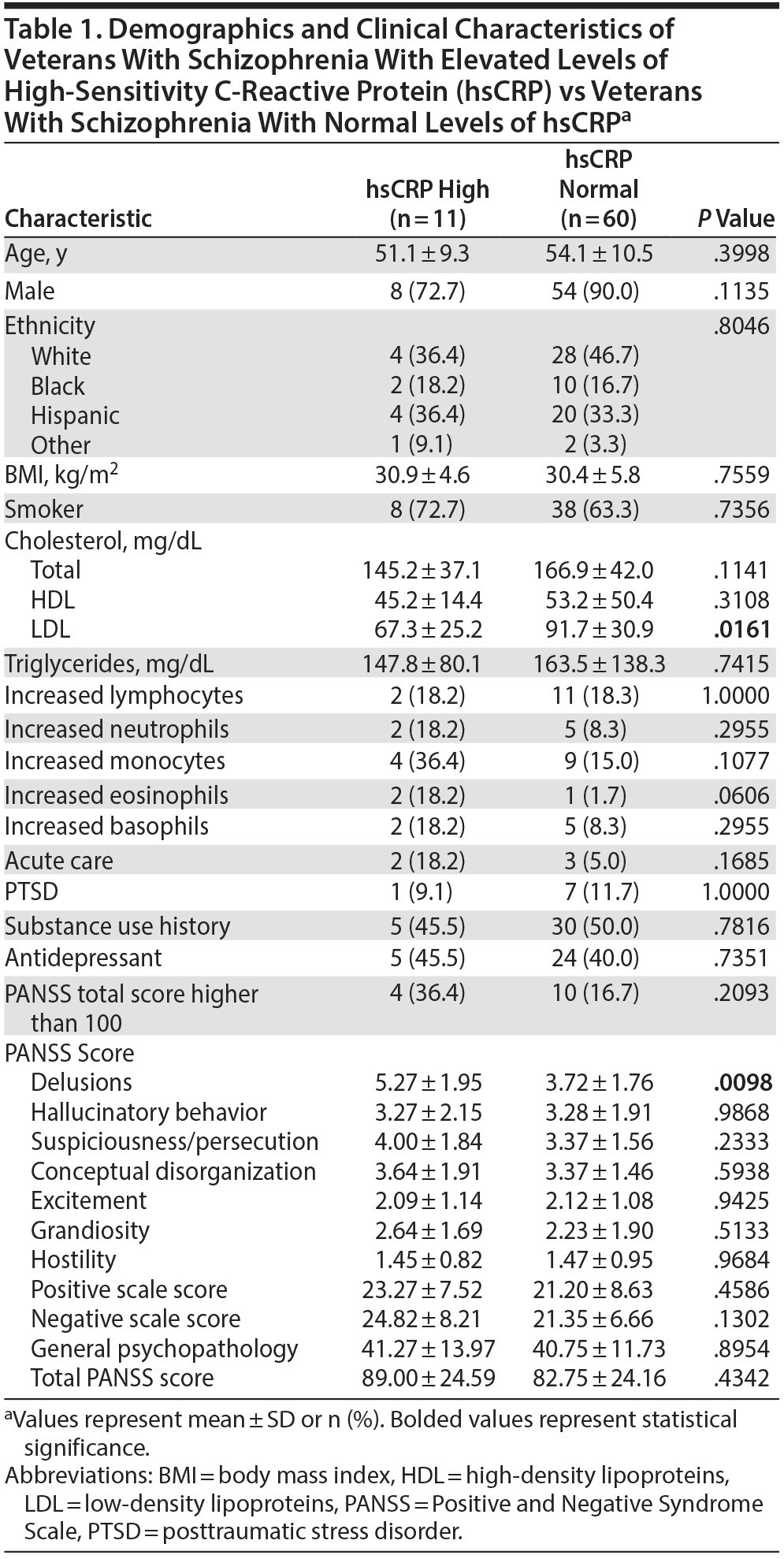Because this piece does not have an abstract, we have provided for your benefit the first 3 sentences of the full text.
To the Editor: Accumulating research evidence supports that inflammation and immunologic dysfunction may have a role in the etiology of psychotic disorders, including schizophrenia. Cytokines, particularly interleukin 6 (IL-6) and IL-1β, are primary inducers of acute phase proteins including C-reactive protein (CRP). We evaluated the levels of 38 cytokines and high-sensitivity CRP (hsCRP) in serum from 71 patients with schizophrenia (DSM-IV).
This work may not be copied, distributed, displayed, published, reproduced, transmitted, modified, posted, sold, licensed, or used for commercial purposes. By downloading this file, you are agreeing to the publisher’s Terms & Conditions.
Elevated Serum Levels of High-Sensitivity C-Reactive Proteins Are Associated With Severe Delusional Symptoms in a Subgroup of Patients With Schizophrenia
To the Editor: Accumulating research evidence supports that inflammation and immunologic dysfunction may have a role in the etiology of psychotic disorders, including schizophrenia.1 Cytokines, particularly interleukin 6 (IL-6) and IL-1β, are primary inducers of acute phase proteins including C-reactive protein (CRP).2,3 We evaluated the levels of 38 cytokines and high-sensitivity CRP (hsCRP) in serum from 71 patients with schizophrenia (DSM-IV). We previously reported the correlation of inflammatory cytokines with positive symptoms in these subjects.4 Here, we hypothesized that differential levels of CRP would be linked to distinct symptoms of psychopathology as measured by in the Positive and Negative Syndrome Scale5 (PANSS) scores.
Method. Serum cytokines levels were measured with Millipore bead-based flow immunoassays (Millipore Corp) in a Luminex 100 system (Luminex Corp). Symptom severity in 71 schizophrenic subjects was evaluated using the PANSS.5 The subjects were evaluated by using the total PANSS scores, general psychopathology scores, negative scale scores, positive scale scores, and the scores from the individual positive subscale PANSS symptoms: Delusions, Hallucinatory behavior, Suspiciousness/persecution, Conceptual disorganization, Excitement, Grandiosity, and Hostility. The levels of 38 cytokines at each visit were correlated with PANSS scores. The measurements of hsCRP were performed at the Veterans Affairs (VA) hospital in San Antonio, Texas, as part of standard of care. Levels of hsCRP above 0.9 mg/dL were flagged as high according to the reference range accepted at the VA clinical laboratory. All statistical analyses were performed using SAS Version 9.3 (SAS Institute Inc., Cary, NC). A P value of < .05 was considered to be statistically significant.
Results. All patients had a long-standing diagnosis of chronic paranoid schizophrenia and were under treatment with antipsychotic medications. We found 11 patients to have levels of hsCRP higher than 0.9 mg/dL. No significant differences in gender, ethnicity, body mass index, or weight were found between subjects with high CRP and those in the normal range (Table 1). No differences in levels of cholesterol, triglycerides, high-density lipoproteins, low-density lipoproteins, and blood counts (assessed at the VA hospital in San Antonio, Texas, as standard of care) were observed. Further, we found no differences in level of care at the time of psychiatric evaluation, smoking habits, comorbidity with posttraumatic stress disorder, or additional treatment with antidepressants (Table 1). The veterans with high levels of hsCRP had no physical signs of infection or exacerbation of medical or surgical problems. Overall, the elevated serum levels of hsCRP were associated with more severe psychopathology.
Table 1 also summarizes the results of association of high levels of hsCRP with psychopathology symptoms estimated by PANSS and multiple comparisons. In the group with high hsCRP, the scores for delusional symptoms were statistically higher compared with the normal-level group, with a P value of .0098 (the highest possible delusional score is 7). To our knowledge, this is the first report of levels of hsCRP positively correlated with specific measures of delusions. Previously it was reported that elevated CRP was a significant predictor of both PANSS total and negative symptoms.6 In another study,7 elevated levels of CRP were associated with more severe cognitive symptoms.
Conclusions and Relevance. This study is limited to testing a pragmatic hypothesis that hsCRP would correlate with severity of psychopathology. It does not accurately estimate potential confounders such as the relationship of hsCRP to cardiovascular disease, and it does not address the molecular mechanisms leading to the observed association with delusions. Our study is also limited by the small sample size and the necessity of adjusting for multiple comparisons. However, our results suggest that measurements of hsCRP may be useful for the clinical care of patients with schizophrenia, in terms of treatment of psychotic symptoms.
References
1. Girgis RR, Kumar SS, Brown AS. The cytokine model of schizophrenia: emerging therapeutic strategies. Biol Psychiatry. 2014;75(4):292-299. PubMed doi:10.1016/j.biopsych.2013.12.002
2. Miller BJ, Buckley P, Seabolt W, et al. Meta-analysis of cytokine alterations in schizophrenia: clinical status and antipsychotic effects. Biol Psychiatry. 2011;70(7):663-671. PubMed doi:10.1016/j.biopsych.2011.04.013
3. Kramer F, Torzewski J, Kamenz J, et al. Interleukin-1β stimulates acute phase response and C-reactive protein synthesis by inducing an NFkappaB- and C/EBPbeta-dependent autocrine interleukin-6 loop. Mol Immunol. 2008;45(9):2678-2689. PubMed doi:10.1016/j.molimm.2007.12.017
4. Dimitrov DH, Lee S, Yantis J, et al. Differential correlations between inflammatory cytokines and psychopathology in veterans with schizophrenia: potential role for IL-17 pathway. Schizophr Res. 2013;151(1-3):29-35. PubMed doi:10.1016/j.schres.2013.10.019
5. Kay SR, Opler LA, Fizbein A, et al. Positive and Negative Syndrome Scale (PANSS) Technical Manual. Toronto, Ontario: Multi-Health Systems Inc.; 2006.
6. Fan X, Pristach C, Liu EY, et al. Elevated serum levels of C-reactive protein are associated with more severe psychopathology in a subgroup of patients with schizophrenia. Psychiatry Res. 2007;149(1-3):267-271. PubMed doi:10.1016/j.psychres.2006.07.011
7. Dickerson F, Stallings C, Origoni A, et al. C-reactive protein is associated with the severity of cognitive impairment but not of psychiatric symptoms in individuals with schizophrenia. Schizophr Res. 2007;93(1-3):261-265. PubMed doi:10.1016/j.schres.2007.03.022
aSouth Texas Veterans Health Care System, San Antonio, Texas
bDepartment of Psychiatry, University of Texas Health Science Center at San Antonio
cDepartment of Psychiatry and Behavioral Sciences, University of Texas Health Science Center at Houston
Potential conflicts of interest: None of the authors have conflicts of interest.
Funding/support: The research has been supported by a New Investigator Award grant to Dimitre Dimitrov, MD, from VISN 17 of the Department of Veterans Affairs.
Role of the sponsor: None.
Disclaimer: The views expressed herein are those of the authors and do not necessarily represent the views of the US Department of Veterans Affairs.
J Clin Psychiatry 2016;77(1):131-132
dx.doi.org/10.4088/JCP.15l09833
© Copyright 2016 Physicians Postgraduate Press, Inc.
This PDF is free for all visitors!





